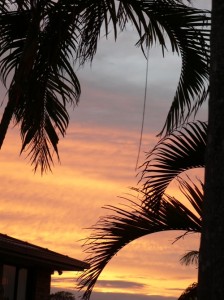Articles
- Emptiness
- Non-Self (Anatma) and Self (Atma)
- No-Self or Not-Self?
Emptiness
 Happiness depends upon seeing our deep connections to other beings. We suffer unnecessarily because we have a persistent sense of ourselves as existing independently, by way of our own private essence.
Happiness depends upon seeing our deep connections to other beings. We suffer unnecessarily because we have a persistent sense of ourselves as existing independently, by way of our own private essence.
Emptiness is the utter nonexistence of any intrinsic nature or real essence. Emptiness does not mean nothingness or meaninglessness. It means that things exist only interdependently, lacking any independent nature.
Knowing emptiness frees us. Our current limitations and faults are not locked into our nature; our minds are open even to radical transformation.
The path to the perfect happiness of a buddha requires (1) wisdom understanding that there is no essential existence and (2) compassion seeking to free all beings from suffering. These two – caring for beings and seeing that all is empty – work synergistically to bring about enlightenment.
Wisdom involves not only seeing the ultimate reality – emptiness – but also making careful distinctions at the conventional level about how best to practice, how best to help others.
To develop profound wisdom knowing emptiness, first study scripture and carefully reflect upon its meaning – guided by a qualified teacher. Study is itself a form of practice. Meditation is deep familiarization with something one has studied and come to understand.
Happiness flows from virtue; all virtue derives from reflecting on facts with an undistracted mind. Thus, the path to buddhahood involves both stabilizing the mind in perfect nondistraction and training in analysis that leads to meditative insight.
The path to enlightenment involves logically refuting in meditation the sense of an essentially real self.
Of the three trainings on the Buddhist path – ethics, meditative stabilization, and wisdom – the first two are similar to many non-Buddhist teachings. What is unique in Buddhism is wisdom, born of analytical meditation, which penetrates the nature of ultimate reality.
To prepare for this, one must study and reflect on definitive scriptures such as the Perfection of Wisdom sutras that teach the final nature of reality as emptiness. To understand these texts, we can rely on Madhyamika interpreters such as Nagarjuna, Aryadeva, Buddhapalita, Chandrkirti, and Shantideva.
Wisdom eradicates the ignorance or delusion that is the root of all misery. This ignorance is a mind that superimposes intrinsic nature, when in fact all things are devoid of such. This “intrinsic nature” or “essential nature” is also sometimes called “self”.
This utter lack of intrinsic nature in persons is “the selflessness of persons”; the utter lack of intrinsic nature in other phenomena is “selflessness of phenomena”. Neither selflessness is more profound; they are the same quality, emptiness, considered in relation to different things.
Source: I am deeply grateful to Guy Newland for these profound, liberating thoughts. The reference, which I highly recommend, is as follows. Newland, Guy. Introduction to Emptiness: As Taught in Tsong-kha-pa’s Great Treatise on the Stages of the Path, revised edition. Ithaca, New York: Snow Lion Publications, 2009. (Pages 114-115: Appendix: The Quintessential Points Chapter by Chapter.)
- For a PDF copy, click on Reflections on Emptiness.
- For an MS Word document, click on Reflections on Emptiness.
Non-Self (Anatma) and Self (Atma)
 The question was asked: How has your sense of identity been challenged by studying the Buddhist teaching of the two truths (relative truth and ultimate truth)?
The question was asked: How has your sense of identity been challenged by studying the Buddhist teaching of the two truths (relative truth and ultimate truth)?
This question about one’s sense of identity deals with the basic, or most fundamental, question of existence: Who am I?
The Buddhist teaching of the two truths shows the relative reality of all that is not ultimate or absolute reality. In other words, there is no reality by the one Reality.
Let me use the example of “non-self”, which is one of the three marks of existence. The Sanskrit word for “non-self” is anatma (in Pali, anatta). In examining the self, I have to conclude that there is not a self at all! What I term self (or ego) is “a reactive process and not a self”, as Junpo Denis Kelly Roshi states in The Heart of Zen (p. 16). “My reactions [are] wholly conditioned and without a separate personal self” (p.17). Understanding relative truth shows me that the self is only a temporary process that is conditioned. A concept of self has arisen in my mind that has been shaped by biological, psychological, and spiritual conditioning in the stream of time. The self is only a process. (pp. 3-23.)
In contrast to my view of a relative self, there would have be an ultimate Self that would in turn have to be deathless and timeless. This leads me to my second example – exploring this Self. I am further challenged by being led to a new understanding of the ultimate or absolute Self in Buddhism.
William Stoddart in his book, An Illustrated Outline of Buddhism, gives a famous incident when the Buddha met a group of people searching for a young woman (the symbol of anatma, or “non-self”). He says to them: “What think ye? Were it not better that ye sought the Self?” (Vinaya Pitaka, i, 23). Stoddart then states that the Buddha made many references to the Self (Atma). For example: “Make the Self your refuge” (Samyutta Nikaya, iii, 143). Also: “Be such as have the Self as your refuge” (Digha Nikaya, ii, 101). Further: “I have made the Self my refuge” (Digha Nikaya, ii, 120). Here we see ultimate Reality – the Self (Atma). Only Atma would have to be fully and truly real. Stoddart concludes by showing that since there can be no reality but the one Reality, this would be the same as stating that “there is no self but the Self”.
This insight has indeed been challenging for me in that I am seeing that the teaching of anatma (non-self) is not a denial of Atma (Self) – as is so very commonly supposed! Rather, it means that those who are overcoming the “three poisons”(illusion, lust, pride) are establishing themselves in Atma – the ultimate Reality!
Sources: In my response to the question asked, I have drawn on two sources. (1) William Stoddart’s book, An Illustrated Outline of Buddhism: The Essentials of Buddhist Spirituality (Bloomington, Indiana: World Wisdom, 2013), pages 43-46. (2) Junpo Denis Kelly Roshi and Keith Martin-Smith, The Heart of Zen: Enlightenment, Emotional Maturity, and What It Really Takes for Spiritual Liberation (Berkeley, CA: North Atlantic Books, 2014), pages 3-23.
- For a PDF copy, click Non-Self (Anatma) and Self (Atma).
- For an MS Word copy, click Non-Self (Anatma) and Self (Atma).
No-Self or Not-Self?
 One of the first stumbling blocks that Westerners often encounter when they learn about Buddhism is the teaching on anatta, often translated as “no-self”. This teaching is a stumbling block for two reasons.
One of the first stumbling blocks that Westerners often encounter when they learn about Buddhism is the teaching on anatta, often translated as “no-self”. This teaching is a stumbling block for two reasons.
First, the idea of there being no self doesn’t fit well with other Buddhist teachings, such as the doctrine of kamma and rebirth: If there’s no self, what experiences the results of kamma and takes rebirth?
Second, it doesn’t fit well with our own Judeo-Christian background, which assumes the existence of an eternal soul or self as a basic presupposition: If there’s no self, what’s the purpose of a spiritual life?
Many books try to answer these questions, but if you look at the Pali canon — the earliest extant record of the Buddha’s teachings — you won’t find them addressed at all. In fact, the one place where the Buddha was asked point-blank whether or not there was a self, he refused to answer.
When later asked why, he said that to hold either that there is a self or that there is no self is to fall into extreme forms of wrong view that make the path of Buddhist practice impossible. Thus the question should be put aside. To understand what his silence on this question says about the meaning of anatta, we first have to look at his teachings on how questions should be asked and answered, and how to interpret his answers.
The Buddha divided all questions into four classes: (1) those that deserve a categorical (straight yes or no) answer; (2) those that deserve an analytical answer, defining and qualifying the terms of the question; (3) those that deserve a counter-question, putting the ball back in the questioner’s court; and (4) those that deserve to be put aside.
The last class of question consists of those that don’t lead to the end of suffering and stress. The first duty of a teacher, when asked a question, is to figure out which class the question belongs to, and then to respond in the appropriate way. You don’t, for example, say “yes” or “no” to a question that should be put aside. If you are the person asking the question and you get an answer, you should then determine how far the answer should be interpreted.
The Buddha said that there are two types of people who misrepresent him: (1) those who draw inferences from statements that shouldn’t have inferences drawn from them, and (2) those who don’t draw inferences from those that should.
These are the basic ground rules for interpreting the Buddha’s teachings, but if we look at the way most writers treat the anatta doctrine, we find these ground rules ignored.
Some writers try to qualify the no-self interpretation by saying that the Buddha denied the existence of an eternal self or a separate self, but this is to give an analytical answer to a question that the Buddha showed should be put aside.
Others try to draw inferences from the few statements in the discourse that seem to imply that there is no self, but it seems safe to assume that if one forces those statements to give an answer to a question that should be put aside, one is drawing inferences where they shouldn’t be drawn.
So, instead of answering “no” to the question of whether or not there is a self — interconnected or separate, eternal or not — the Buddha felt that the question was misguided to begin with. Why?
No matter how you define the line between “self” and “other,” the notion of self involves an element of self-identification and clinging, and thus suffering and stress. This holds as much for an interconnected self, which recognizes no “other,” as it does for a separate self. If one identifies with all of nature, one is pained by every felled tree. It also holds for an entirely “other” universe, in which the sense of alienation and futility would become so debilitating as to make the quest for happiness — one’s own or that of others — impossible.
For these reasons, the Buddha advised paying no attention to such questions as “Do I exist?” or “Don’t I exist?” for however you answer them, they lead to suffering and stress.
To avoid the suffering implicit in questions of “self” and “other,” he offered an alternative way of dividing up experience: the four Noble Truths of (1) stress, (2) its cause, (3) its cessation, and (4) the path to its cessation. Rather than viewing these truths as pertaining to self or other, he said, one should recognize them simply for what they are, in and of themselves, as they are directly experienced, and then perform the duty appropriate to each.
Stress should be comprehended, its cause abandoned, its cessation realized, and the path to its cessation developed. These duties form the context in which the anatta doctrine is best understood. If you develop the path of virtue, concentration, and discernment to a state of calm well-being and use that calm state to look at experience in terms of the Noble Truths, the questions that occur to the mind are not “Is there a self? What is my self?” but rather “Am I suffering stress because I’m holding onto this particular phenomenon? Is it really me, myself, or mine? If it’s stressful but not really me or mine, why hold on?”
These last questions merit straightforward answers, as they then help you to comprehend stress and to chip away at the attachment and clinging — the residual sense of self-identification — that cause it, until ultimately all traces of self-identification are gone and all that’s left is limitless freedom.
In this sense, the anatta teaching is not a doctrine of no-self, but a not-self strategy for shedding suffering by letting go of its cause, leading to the highest, undying happiness. At that point, questions of self, no-self, and not-self fall aside. Once there’s the experience of such total freedom, where would there be any concern about what’s experiencing it, or whether or not it’s a self?
©1996 Thanissaro Bhikkhu.
Source: “No-self or Not-self?”, by Thanissaro Bhikkhu. Access to Insight (Legacy Edition), 24 November 2013, http://www.accesstoinsight.org/lib/authors/thanissaro/notself2.html . Minor style edits made by Alexander Peck.
Note: The text of this page (“No-self or Not-self?”, by Thanissaro Bhikkhu) is licensed under a Creative Commons Attribution-NonCommercial 4.0 International License. To view a copy of the license, visit http://creativecommons.org/licenses/by-nc/4.0/. Documents linked from this page may be subject to other restrictions. Transcribed from a file provided by the author. Last revised for Access to Insight on 24 November 2013.
- For a PDF copy, click No-self or Not-self?
- For an MS Word copy, click No-self or Not-self?
